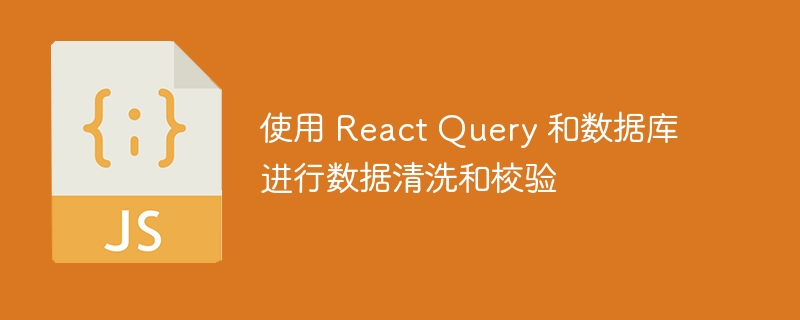

Use React Query and database for data cleaning and verification
In modern web application development, processing and managing front-end data is a very important task. React Query is a powerful library that can help us with data management, and the database is an important tool for storing application data. This article will introduce how to use React Query and the database for data cleaning and verification, and provide specific code examples.
1. Background
Now assume that we have a simple task management application where users can create tasks and save them to the database. During the task creation process, we need to clean and verify the data entered by the user to ensure the validity and consistency of the data. At the same time, we also need to save the task data to the database for future query and use.
2. Data cleaning and verification
npm:
npm install react-query
yarn:
yarn add react-query
import React from 'react';
import { QueryClient, QueryClientProvider } from 'react-query';
const queryClient = new QueryClient();
function App() {
return (
<QueryClientProvider client={queryClient}>
{/* 应用的其他组件 */}
</QueryClientProvider>
);
}
export default App;import React from 'react';
import { useMutation } from 'react-query';
function CreateTaskForm() {
const createTaskMutation = useMutation((newTask) => {
// 执行任务创建的逻辑
return fetch('/api/tasks', {
method: 'POST',
body: JSON.stringify(newTask),
}).then((response) => response.json());
});
const handleSubmit = (event) => {
event.preventDefault();
const form = event.target;
const formData = new FormData(form);
const newTask = {
title: formData.get('title'),
description: formData.get('description'),
// 其他字段
};
createTaskMutation.mutate(newTask);
};
return (
<form onSubmit={handleSubmit}>
<input type="text" name="title" />
<textarea name="description" />
{/* 其他输入框 */}
<button type="submit">创建任务</button>
</form>
);
}In the above example, we used a mock API /api/tasks to simulate the task creation request and return the task details after the request is successful. .
First, we need to install Mongoose:
npm:
npm install mongoose
yarn:
yarn add mongoose
Then, create a db in the project .js file and add the following code:
const mongoose = require('mongoose');
mongoose.connect('mongodb://localhost:27017/my-database', {
useNewUrlParser: true,
useUnifiedTopology: true,
});
const TaskSchema = new mongoose.Schema({
title: {
type: String,
required: true,
},
description: {
type: String,
required: true,
},
createdAt: {
type: Date,
default: Date.now,
},
// 其他字段
});
const TaskModel = mongoose.model('Task', TaskSchema);
module.exports = TaskModel;In the above code, we define a simple task model and export the model for use elsewhere in the application.
import React from 'react';
import { useMutation } from 'react-query';
import TaskModel from './db';
function CreateTaskForm() {
const createTaskMutation = useMutation((newTask) => {
// 执行任务创建的逻辑
return TaskModel.create(newTask); // 使用 Mongoose 保存任务数据
});
// 其他代码
return (
{/* 表单代码 */}
);
}In the above example, we use the TaskModel.create method to save task data to the database.
3. Summary
By using React Query and the database, we can easily clean and verify the front-end data and save it to the database. This ensures the validity and consistency of the data and improves the user experience and data quality of the application. The above sample code is just a simple example. In actual projects, it can be expanded and optimized according to needs to meet specific business needs.
The above is the detailed content of Use React Query and database for data cleaning and validation. For more information, please follow other related articles on the PHP Chinese website!
 What is ESD file?
What is ESD file?
 What is the article tag used to define?
What is the article tag used to define?
 How to solve parsererror error
How to solve parsererror error
 How to solve the problem of black screen after turning on the computer and unable to enter the desktop
How to solve the problem of black screen after turning on the computer and unable to enter the desktop
 How to configure jsp virtual space
How to configure jsp virtual space
 Complete collection of SQL query statements
Complete collection of SQL query statements
 what is css
what is css
 what is adobe flash player
what is adobe flash player




